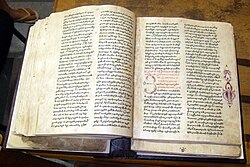Synaxarium

SynaxarionorSynexarion(pluralsSynaxaria,Synexaria;Greek:Συναξάριον,from συνάγειν,synagein,"to bring together"; cf.etymologyofsynaxisandsynagogue;Latin:Synaxarium,Synexarium;Coptic:ⲥⲩⲛⲁⲝⲁⲣⲓⲟⲛ;Ge'ez:ሲናክሳሪየም(ስንክሳር);Arabic:ٱلسِّنْكِسَارُ/ٱلسَّنْكِسَارُ/ٱلسِّنَكْسَارُ,romanized:As-sinkisār/As-sankisār/As-sinaksār[1][2][3]) is the name given in theEastern Orthodox,Oriental OrthodoxandEastern Catholic Churchesto a compilation ofhagiographiescorresponding roughly to themartyrologyof theRoman Church.
There are two kinds of synaxaria:[4]
- Simple synaxaria:lists of thesaintsarranged in the order of their anniversaries, e.g. the calendar ofMorcelli[4]
- Historical synaxaria:including biographical notices, e.g. theMenologion of Basil IIand the synaxarium ofSirmond.[4]The notices given in the historical synaxaria are summaries of those in the great menologies, or collections of lives of saints, for the twelve months of the year.[4]As the lessons in the ByzantineDivine Officeare mostly the lives of saints, the Synaxarion became the collection of short lives of saints and martyrs, but also of accounts of events, of famous visions seen by saints and even useful narratives whose memory is kept.[5][6]
Definitions
[edit]The exact meaning of the name has changed at various times. Its first use was for the index to the Biblical and other lessons to be read in church. In this sense it corresponds to the LatinCapitulareandComes.Then the Synaxarion was filled up with the whole text of thepericopesto be read. As far as theHoly Liturgywas concerned this meant that it was essentially transformed into the "Gospel" and "Apostle" books. Synaxarion remained the title for the index to the other lessons. Without changing its name it was filled up with complete texts of these lessons.[5]The mere index of such lessons is generally calledmenologion heortastikon,a book now hardly needed or used, since theTypikonsupplies the same, as well as other, information.[5]
Certain calendars extant in the Middle Ages were also called Synaxaria.Krumbacherdescribes those composed byChristopher of MytileneandTheodore Prodromus(twelfth century).[7]
Examples
[edit]The oldest historical synaxaria apparently go back to the tenth century.[4]There are a great number of medieval synaxaria extant in manuscript. They are important for Byzantineheortologyand church history. The short lives that form the lessons were composed or collected by various writers.[5]Of theseSymeon Metaphrastesis the most important. The accounts are of very varying historical value. EmperorBasil II(976-1025) ordered a revision of the synaxarion, which forms an important element of the present official edition.[8]The synaxarion is not now used as a separate book; it is incorporated in the Menaia. The account of the saint orfeastis read in theOrthrosafter the sixth ode of the Canon. It is printed in its place here, and bears each time the name synaxarion as title. Synaxarion then in modern use means, not the whole collection, but each separate lesson in the Menaia and other books. An example of such a synaxarion (for St. Martin I, 13 April) will be found inNilles,op. cit., infra, I, xlix.[5]Some surviving examples of regional Synaxaria are:
- The Coptic Synaxarium- Also known as theSynaxarium Alexandrinum,which is employed by theCoptic Orthodox Churchwas started simultaneously by J. Forget in theCorp. script. orient..It was written using the Coptic language (Coptic:ⲥⲩⲛⲁⲝⲁⲣⲓⲟⲛ)[9]before the adoption of Arabic as an official language of Egypt.[10]
- The Ethiopian Synaxarium- which belongs to theEthiopianwas begun byI. Guidiin thePatrologia orientalis,as well as byE.A. Wallis Budge.[11]
- The Armenian Synaxarium of Ter Israel- which is used by theArmenian Apostolic Church[12]was published atConstantinoplein 1834, and again inPatrologia Orientalis.
- The Georgian Synaxarium- There are also variousGeorgiansynaxaria, surviving in various complete states.[13][4][14]
- TheRoman Martyrology- which is utilized by theRoman Catholic Churchfor its calendar of saints.[15]
- The Arab-Jacobite Synaxarium- which is composed inArabic(Arabic:السِّنْكِسارُ) and used by theSyriac Orthodox Church.
Byzantine usage
[edit]During the Eastern OrthodoxDivine Servicesthe reading of the synaxarion (in the sense of brief lives of the saints of the day) will take place after the Sixth Ode of theCanonatMatinsor at theDivine Liturgy.The synaxaria may be printed in a separate volume or may be included with other liturgical texts such as theMenaionorHorologion.
See also
[edit]Notes
[edit]- ^Team, Almaany."ترجمة و معنى السنكسار بالإنجليزي في قاموس المعاني. قاموس عربي انجليزي الكل مصطلحات صفحة 1".www.almaany.com.Retrieved2022-09-24.
- ^Team, Almaany."تعريف و شرح و معنى سنكسار بالعربي في معاجم اللغة العربية معجم المعاني الجامع، المعجم الوسيط ،اللغة العربية المعاصر ،الرائد ،لسان العرب ،القاموس المحيط - معجم عربي عربي صفحة 1".www.almaany.com.Retrieved2022-09-24.
- ^"السنكسار بحسب الكنيسة المارونية".www.mecliban.com.Retrieved2022-09-24.
- ^abcdefDelehaye 1911,p. 292.
- ^abcdeFortescue 1912.
- ^Συναξαριστής των Δώδεκα μηνών του ενιαυτού», 1805-1807, στην Ι.Μ.Παντοκράτορος, εκδ.Βενετία, 1819
- ^Fortescue 1912cites Krumbacher "Gesch. der byzantin. Lit.", 2nd ed., Munich, 1897, pp. 738, 755
- ^Fortescue 1912cites Analecta Bollandiana, XIV, 1895, p. 404.
- ^Michael Ghlay - Alexandria - Egypt."السنكسار | كتاب سنكسار القديسين الخاص بالكنيسة القبطية الأرثوذكسية - السنكسارات".St-Takla.org.Retrieved2022-09-04.
- ^"السنكسار: Lives of Saints: Synaxarium - CopticChurch.net".
- ^https://www.tewahedo.dk/litt/cached/The_Ethiopian_Synaxarium.pdf
- ^"The Haysumavurk (Synaxarion) and Lives of the Martyrs – VEMKAR".
- ^N. Marr,Le Synaxaire géorgien. Rédaction ancienne de l'union arméno-géorgienne,Paris 1926 (Patrologia Orientalis, 19, 5 = 95); G. Garitte,Le calendrier palestino-géorgien du Sinaiticus 34 (Xesiècle).Édité, traduit et commenté..., Bruxelles 1958 (Subsidia hagiographica, 30).
- ^Curtin, D. P. (1 Aug 2022).The Georgian Synaxarium.Dalcassian Publishing Company.ISBN9781960069696.
- ^"Roman Martyrology, Complete, in English for Daily Reflection".
References
[edit]- Attribution
 This article incorporates text from a publication now in thepublic domain:Fortescue, Adrian (1912). "Synaxarion".In Herbermann, Charles (ed.).Catholic Encyclopedia.Vol. 14. New York: Robert Appleton Company.
This article incorporates text from a publication now in thepublic domain:Fortescue, Adrian (1912). "Synaxarion".In Herbermann, Charles (ed.).Catholic Encyclopedia.Vol. 14. New York: Robert Appleton Company.- This article incorporates text from a publication now in thepublic domain:Delehaye, Hippolyte(1911). "Synaxarium".InChisholm, Hugh(ed.).Encyclopædia Britannica.Vol. 26 (11th ed.). Cambridge University Press. p. 292.
Further reading
[edit]- Stefano Antonio Morcelli,Kalendarium ecclesiae Constantinopolitanae(Rome, 1788) Online onGoogle Books:vol. 1;vol. 2
- Hippolyte Delehaye,"Le Synaxaire de Sirmond," inAnalecta Bollandiana,xiv. 396–434, where the terminology is explained; idem,Synaxarium ecclesiae Constantinopolitanae e codice Sirmondiano(Brussels, 1902), forming the volumePropylaeum ad acta sanctorum novembris.
External links
[edit]- Introduction to The Synaxarion:The Lives of the Saints of the Orthodox Church, by Hieromonk Makarios of Simonos Petra, Mount Athos
